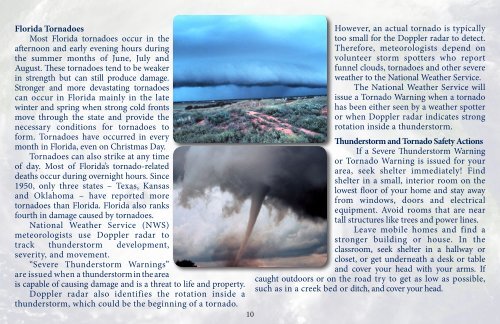2015 Guide
2015 Guide
2015 Guide
You also want an ePaper? Increase the reach of your titles
YUMPU automatically turns print PDFs into web optimized ePapers that Google loves.
Florida Tornadoes<br />
Most Florida tornadoes occur in the<br />
afternoon and early evening hours during<br />
the summer months of June, July and<br />
August. These tornadoes tend to be weaker<br />
in strength but can still produce damage.<br />
Stronger and more devastating tornadoes<br />
can occur in Florida mainly in the late<br />
winter and spring when strong cold fronts<br />
move through the state and provide the<br />
necessary conditions for tornadoes to<br />
form. Tornadoes have occurred in every<br />
month in Florida, even on Christmas Day.<br />
Tornadoes can also strike at any time<br />
of day. Most of Florida’s tornado-related<br />
deaths occur during overnight hours. Since<br />
1950, only three states – Texas, Kansas<br />
and Oklahoma – have reported more<br />
tornadoes than Florida. Florida also ranks<br />
fourth in damage caused by tornadoes.<br />
National Weather Service (NWS)<br />
meteorologists use Doppler radar to<br />
track thunderstorm development,<br />
severity, and movement.<br />
“Severe Thunderstorm Warnings”<br />
are issued when a thunderstorm in the area<br />
is capable of causing damage and is a threat to life and property.<br />
Doppler radar also identifies the rotation inside a<br />
thunderstorm, which could be the beginning of a tornado.<br />
10<br />
However, an actual tornado is typically<br />
too small for the Doppler radar to detect.<br />
Therefore, meteorologists depend on<br />
volunteer storm spotters who report<br />
funnel clouds, tornadoes and other severe<br />
weather to the National Weather Service.<br />
The National Weather Service will<br />
issue a Tornado Warning when a tornado<br />
has been either seen by a weather spotter<br />
or when Doppler radar indicates strong<br />
rotation inside a thunderstorm.<br />
Thunderstorm and Tornado Safety Actions<br />
If a Severe Thunderstorm Warning<br />
or Tornado Warning is issued for your<br />
area, seek shelter immediately! Find<br />
shelter in a small, interior room on the<br />
lowest floor of your home and stay away<br />
from windows, doors and electrical<br />
equipment. Avoid rooms that are near<br />
tall structures like trees and power lines.<br />
Leave mobile homes and find a<br />
stronger building or house. In the<br />
classroom, seek shelter in a hallway or<br />
closet, or get underneath a desk or table<br />
and cover your head with your arms. If<br />
caught outdoors or on the road try to get as low as possible,<br />
such as in a creek bed or ditch, and cover your head.


